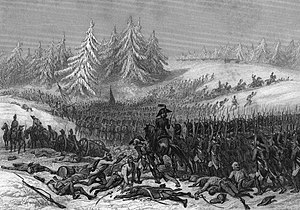Charter War: Difference between revisions
mNo edit summary |
No edit summary |
||
| Line 43: | Line 43: | ||
The '''Charter War''', sometimes known as the '''Four Years' War''', was a major Novaran conflict instigated primarily by the proclamation of the liberal Charter of Privileges in Tretrid, which sparked fears of destabilization caused by the spread of liberalism. It was fought between a coalition led by [[Celanora]] and [[Lapinumbia]] against the [[House of Cenhelm|Cenhelming monarchies]] of Tretrid and Seccera. |
The '''Charter War''', sometimes known as the '''Four Years' War''', was a major Novaran conflict instigated primarily by the proclamation of the liberal Charter of Privileges in Tretrid, which sparked fears of destabilization caused by the spread of liberalism. It was fought between a coalition led by [[Celanora]] and [[Lapinumbia]] against the [[House of Cenhelm|Cenhelming monarchies]] of Tretrid and Seccera. |
||
==Background== |
|||
===Republicanism in Tretrid=== |
|||
As the result of a religious schism within [[Ulvriktru]], Tretrid spent much of the later 18th century waging the Ulvriktru Wars of Religion against [[Norgsveldet]]. In backing its cause, Tretrid not only used the religious justification of the Ulvriktruar split but also fueled the development and spread of a new ideology, Gothiric Republicanism, which Tretridian intellectuals often synthesized with rationalist ideas appearing in West Novaris. By the end of the Wars of Religion, [[Jarisven]] and Ostretheia had become Gothiric Republics. King Bada II also adopted many trappings of Gothiric Republican governance, such as establishing the College of Gothirs to govern matters of religion independently from the crown. |
|||
However, the Tretridian monarchy was not immune to criticism. Bada was criticized for his unwritten control over the College of Gothirs, often being lambasted as a 'shadow Fylkir,' supposedly in the name of safeguarding their authority. Some Gothiric republicans even called into question the necessity of the Tretridian monarchy, arguing that the duty to protect the faith was a shared civic duty of the people, and that thus a democratic republic led by rational ideas was the ideal form of government. |
|||
By the time of Bada's death in 1802, Tretrid had largely run its treasury dry from funding almost thirty years of wars fought overseas, and portions of the [[Witenagemot]] were increasingly clamoring for reforms. |
|||
===Revolution in Seccera=== |
|||
{{main|Secceran Revolution}} |
|||
===Constitutionalism and the coalition=== |
|||
[[Category:Tret's links]] |
[[Category:Tret's links]] |
||
Revision as of 15:34, 2 April 2024
| This page (or section) is a work in progress by its author(s) and should not be considered final. |
| Charter War | |||||||||
|---|---|---|---|---|---|---|---|---|---|
 | |||||||||
| |||||||||
| Belligerents | |||||||||
|
|
| ||||||||
| Commanders and leaders | |||||||||
|
| |||||||||
The Charter War, sometimes known as the Four Years' War, was a major Novaran conflict instigated primarily by the proclamation of the liberal Charter of Privileges in Tretrid, which sparked fears of destabilization caused by the spread of liberalism. It was fought between a coalition led by Celanora and Lapinumbia against the Cenhelming monarchies of Tretrid and Seccera.
Background
Republicanism in Tretrid
As the result of a religious schism within Ulvriktru, Tretrid spent much of the later 18th century waging the Ulvriktru Wars of Religion against Norgsveldet. In backing its cause, Tretrid not only used the religious justification of the Ulvriktruar split but also fueled the development and spread of a new ideology, Gothiric Republicanism, which Tretridian intellectuals often synthesized with rationalist ideas appearing in West Novaris. By the end of the Wars of Religion, Jarisven and Ostretheia had become Gothiric Republics. King Bada II also adopted many trappings of Gothiric Republican governance, such as establishing the College of Gothirs to govern matters of religion independently from the crown.
However, the Tretridian monarchy was not immune to criticism. Bada was criticized for his unwritten control over the College of Gothirs, often being lambasted as a 'shadow Fylkir,' supposedly in the name of safeguarding their authority. Some Gothiric republicans even called into question the necessity of the Tretridian monarchy, arguing that the duty to protect the faith was a shared civic duty of the people, and that thus a democratic republic led by rational ideas was the ideal form of government.
By the time of Bada's death in 1802, Tretrid had largely run its treasury dry from funding almost thirty years of wars fought overseas, and portions of the Witenagemot were increasingly clamoring for reforms.